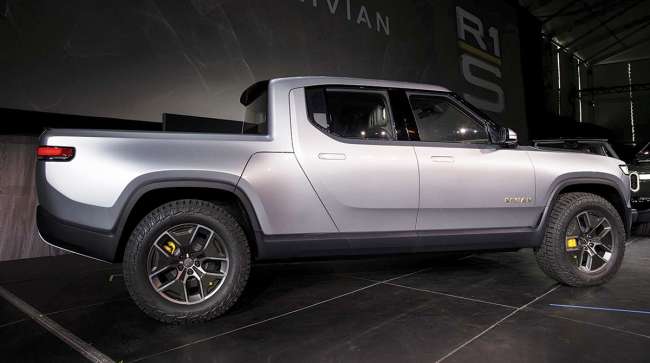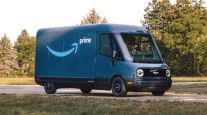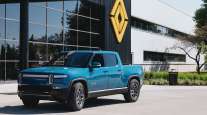Bloomberg News
Rivian Seeks 3-in-a-Row EV Debuts, Defying History

[Stay on top of transportation news: Get TTNews in your inbox.]
Rivian Automotive Inc., the electric-truck startup backed by Amazon.com Inc., is running the automotive equivalent of a three-ring circus: attempting to launch a trio of new vehicles in a factory that made its last car six years ago.
The push reflects a desire to get ahead of battery-powered trucks from more established rivals, including a Hummer pickup from General Motors Co. and Tesla Inc.’s Cybertruck. Rivian has high hopes for its pickup and SUV but is counting on an Amazon-dedicated delivery van as a guaranteed source of revenue, people familiar with the company’s strategy said.
Rivian hasn’t publicly stated its production goals, but these people said the startup is building annual capacity for about 300,000 vehicles and aims to make as many as 40,000 in its first full year — or an average of almost 800 a week. That compares with the nearly 5,000 vehicles a week Tesla manufactured at its factory in Fremont, Calif., in 2018 — the first full year of production for the mass-market Model 3 sedan.
Amazon and Ford Motor Co. are providing financing and operational advice, but output of that magnitude across three different models is a tall order for an untested business.
“It’s such a huge step going from producing prototypes to actually putting together a thousand vehicles a week,” said Mark Wakefield, head of the automotive practice in the Americas at consultant AlixPartners LLP, who advises startups. “It’s hard to overemphasize that point.”
A spokesperson for Rivian declined to comment on its production targets.
Retrofitted Plant
The Irvine, Calif.-based company’s three-vehicle gambit is playing out in a 2.4 million-square-foot factory 38 miles east of Peoria, Ill., in the central part of the state. The former Mitsubishi Motors Corp. plant has been retrofitted with advanced robotic and other production technology to match the innovation of the vehicles to be manufactured there.
Charging Up
Engineers, technicians and other staff are swarming the plant in an all-out effort to keep the schedule from slipping further after experiencing COVID-19 and supplier-related delays last year. They have taken over entire hotels in the college town of Normal, Ill., where the factory is located. Pre-production builds of Rivian’s R1T pickup and R1S SUV already are moving down a purpose-built, high-tech pilot line, as engineers work the bugs out.
The R1S in Rivian Blue. We can’t think of a better way to roll into the weekend. pic.twitter.com/d3w6UZD1Xr — Rivian (@Rivian) January 29, 2021
“They are not only launching vehicles, they’re launching a plant,” said Jeff Schuster, president of Americas and global vehicle forecasting at researcher LMC Automotive. “So their risks are stacked.”
Adding to the complexity, CEO R.J. Scaringe is planning to take the company public as soon as the end of this year, and he’s scouting locations for a European factory, according to people familiar with its plans. Rivian is expected to be valued at about $50 billion when it goes public, they said.
The company’s ability to execute on its daring plans rests largely on its ringmaster. The 38-year-old Scaringe, who holds a Ph.D from Massachusetts Institute of Technology, is months away from achieving a goal to manufacture EVs set 12 years ago when he founded the company. He later secured seed money from early-stage Saudi and Japanese interests that shared his vision.
Even before making its first car or truck, Rivian made a name for itself based on its innovative flexible-vehicle architecture— and its fundraising prowess. Scaringe’s vision for zero-emission SUVs and trucks has attracted more than $8 billion in investment from corporate partners and Wall Street institutions including D1 Capital Partners, Fidelity Investments and T. Rowe Price Group Inc.
Daunting Historical Odds
In the high-stakes business of carmaking, rolling out just a single model is an undertaking that has bankrupted many contenders, including DeLorean and Fisker Automotive. And even electric-vehicle market leader Tesla started off with just one car. But starting this summer, Rivian plans to pump out its debut battery-powered pickup, SUV and van in the space of a few months.
“Getting off the ground alone is a big deal for an EV startup, but Rivian takes on the added complication of having three models come out in the same year,” said Sam Fiorani, vice president of global vehicle forecasting for researcher AutoForecast Solutions. “How many American automotive companies have started since World War II and been successful? It’s a list of one — Tesla.”

Fleets are investing in tech-based safety tools that inform and forewarn potential risk. But how do they condition and prepare drivers to respond to safety alerts? Find out as the RoadSigns Team speaks with Tom DiSalvi, VP of safety at Schneider National, and Charlie Mohn, director of product innovation at Drivewyze. Hear a snippet, above, and get the full program by going to RoadSigns.TTNews.com.
The CEO’s ambition surpasses what Elon Musk accomplished with Tesla, which started with the low-volume Roadster before slowly ramping up output and expanding its lineup. That Palo Alto, Calif.-based company, founded in 2003 and currently worth about $550 billion, didn’t surpass sales of 40,000 vehicles until 2015 and took another three years to top 300,000 in annual vehicle sales.
The pickup is set to launch in June, followed by the SUV in August and the Amazon van in the fall. The three models are all built atop the same electric “skateboard” platform that is assembled on two dedicated lines. Production then branches off further and vehicles are fitted with what engineers call “top hats” distinguishing them as pickups, SUVs or delivery vans.
Embracing Investors’ Expertise
Tesla repeatedly missed production deadlines when it first attempted to mass produce its bestselling Model 3 sedan. CEO Musk underscored that difficulty in a March 4 tweet about the challenges confronting newer carmakers: “Prototypes are easy, production is hard & being cash flow positive is excruciating.”
But unlike that EV kingpin — who disdained traditional automotive orthodoxy and learned lessons the hard way — Rivian has embraced outside expertise in the form of two of its key investors: Amazon and Ford.
Amazon provided assistance last spring to help restore activity at the automaker’s plant after the pandemic temporarily shut down operations. It has ordered 100,000 vans from Rivian over the span of a decade, including 10,000 by late 2022.
Ford provided early advice on manufacturing and engineering. A Ford subsidiary helped with the huge dies that stamp out the body panels of Rivian’s models, said the people knowledgeable about the companies.
Representatives for Amazon and Ford had no comment.
Rivian was planning what would have been a fourth vehicle — an upscale EV to be co-developed with Ford for its Lincoln luxury line— but scrapped those plans in April, blaming the pandemic. Ford says it still intends to build a model with Rivian, but when and what type of vehicle remains undecided.
“They’ve got their hands full,” Hau Thai-Tang, Ford’s product development chief, said in a recent interview. “We’ve got to let them get through that first.”
Want more news? Listen to today's daily briefing below or go here for more info:




